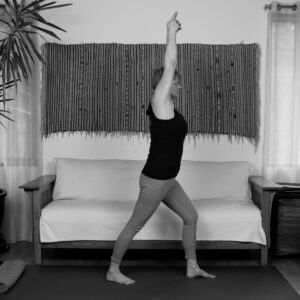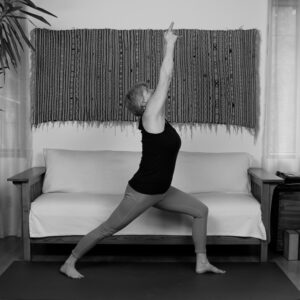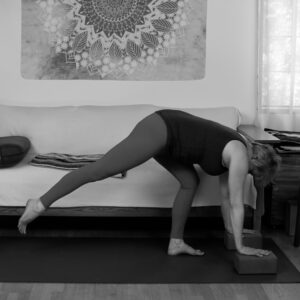
Beginner’s Mind for Total Hip Replacement
Picture a baby as it takes in its brand new world. It has no conditioning to distort the wonder and newness around it. For total hip replacement, adopting a beginner’s mind, as though you were coming to yoga for the first time, opens us to new experiences and sensations, and helps us avoid habitual movements which could compromise our new prosthesis. Keeping an open and curious mind allows us to understand what the body is communicating to us, allows us to see what is going on in the moment, and offers the opportunity to adjust as necessary.
Slow Down
I am a big fan of moving slowly in yoga. When you slow down it allows subtle sensations and messages from the body to come to the fore which offers the opportunity to make choices about how you might want to modify movement.
For example: Let’s say you are having pain in your knee while transitioning from a forward fold to a lunge. You lift a leg and step back, and then wonder why your front knee hurts. If you make the transition slowly, you may realize that you are putting excess weight on one side of your fore foot and this is when you feel the pain begin in the knee. With slow motion you can suss that you may need to change the distribution of weight in you front foot as you take your step back. It may take many slow repetitions with the modified movement but eventually you will create a new pattern in the body and then you can move on… say, to focus on how that back leg is landing!
Be Curious
Focusing your attention on your own needs is a great act of loving-kindness. Back to the analogy of a child, when he/she/they come to you in distress, one of the kindest things you can do is to pay close attention and understand what is bothering them. The same applies to yourself. If your body sends you distress signals, loving attention is the first step toward the possibility of healing. So be curious about the state of affairs and don’t ignore the messages whether subtle or strong. Cultivate your beginner’s mind for the care of your total hip replacement.
Start Small
As you recover from total hip replacement and feel ready to return to your yoga practice, start by practicing your poses at the most easily modified stage. For example, for standing poses start with a narrow foot stance and work with the feet, leg and pelvis position, adding arms at the end. At the beginning, smaller movements can help you to refine your technique and prepare you for when you feel ready to take your pose to a wider or deeper position.
For example: As you return to Warrior I / Virabhadrasana I, keep your feet about 1- 1 1/2 feet (0.3 – 0.45 meters) apart. Focus on the tracking of your front foot and leg, on the angle of the back foot, and on the forward orientation of the pelvis. Observe sensations. Don’t be afraid to modify to even a more narrow stance if things don’t feel right. Practice on both sides. Using the same foot distance on both sides and holding the pose for the same amount of time (I time how long I hold a pose by counting my breaths). If you feel restrictions on one side then stay at that level for both sides until the more restricted side feels ready to move on. This way you will keep your body symmetry in balance as you progress.


The all videos in this program offer modifications for each pose so you can practice at the level that is right for you.
Find your beginner’s mind, stay curious,
honor cues from your body, and relish the present moment!
Here’s to healthy and happy hips!
Key Takeaways
- Adopt a Beginner’s Mind: Approach your yoga practice after total hip replacement as if it’s brand new free from expectations or old habits. This mindset supports safe exploration and healing.
- Move Slowly: Slowing down your transitions in yoga reveals subtle feedback from your body, helping you notice and correct misalignments that could lead to discomfort or strain.
- Be Curious: Listen to your body’s signals with kindness and interest. Treat physical discomfort as information rather than something to ignore or push through.
- Start Small: Begin with simplified or modified versions of poses. Focus on form and sensation before deepening your stretches or widening your stance.
- Balance Progress Symmetrically: If one side of the body feels more restricted, work at the same level on both sides until they feel balanced to avoid asymmetrical strain.
Frequently Asked Questions (FAQs)
1. Why is a beginner’s mindset important after hip replacement surgery? It encourages awareness, curiosity, and openness, helping you avoid old movement patterns that may no longer be safe post-surgery.
2. What does “moving slowly” help with in yoga after hip replacement? It helps you tune into subtle sensations and better understand how your body responds to specific movements, allowing for safer and more effective practice.
3. How soon can I start doing poses like Warrior I? Once cleared by your surgeon or physical therapist, you can begin with a narrower stance and gradually build up, always prioritizing comfort and symmetry.
4. What should I do if one side of my body feels tighter or more restricted? Modify both sides to match the more restricted side until you regain balance. This approach prevents overcompensating and promotes even healing.
5. Do I need to use props or modifications? Yes, using modifications and props is encouraged. All videos in the program offer pose variations to match your level and needs.
Member Videos: Warrior I / Virabhadrasana I, Lunges in Transition and for Strength
Non-Member Preview: Standing Poses
Free video: Yoga while healing from Total Hip Replacement Surgery: A safe post-op asana practice
Become a member of Yoga for Hip Replacement here
Articles and Studies:
Go Slow: Build New Neural Pathways
This is your Brain on Mindfulness
Slowing Down: The Power of Pausing
Talk to your surgeon or healthcare provider before beginning any athletic program.
Download PDF of informational flyer here
© 2021 Yoga for Hip Replacement | Privacy Policy | Terms of Use

